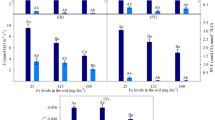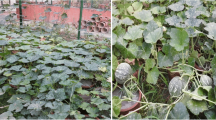Abstract
Increasing concentrations of carbon dioxide and heavy metals in soils through pollution are serious problems worldwide. In the present study, we investigated the impacts of elevated atmospheric CO2 and fly ash (FA)-amended soil on the physiological response (chlorophyll content, non-structural carbohydrates, oil and total proteins) of soybean [Glycine max (L.) Merrill] at three growth stages (vegetative, reproductive and maturity). An increase in plant growth and biomass was observed at elevated CO2 and for moderate concentrations of FA in amended soils in all development plant stages. In contrast to these results, a different response pattern was found for the chlorophyll content and non-structural carbohydrates in relation to the developmental stage, showing that even though in the vegetative growth stage the highest concentration of chlorophylls corresponded to elevated CO2 conditions. An opposite result was observed during the grain filling stage (reduction of chlorophylls of 15 % at ambient CO2 conditions for the treatments 10, 15, and 25 % of FA), which probably is related with the distribution of nutrients at this stage. Regarding to oil and total protein content an increase was observed at elevated CO2 and high concentrations of FA in amended soils. Our findings demonstrate that elevated CO2 and FA-amended soils alter the physiological response of soybean affecting the crop quality.


Similar content being viewed by others
References
Ainsworth EA, Davey PA, Bernacchi CJ, Dermody OC, Heaton EA, Moore DJ, Morgan PB, Naidu SI, Yoo Ra HS, Zhu XG, Curtis PS, Long SP (2002) A meta-analysis of elevated CO2 effects on soybean (Glycine max) physiology, growth and yield. Global Change Biol 8:695–709
Allen LH, Bisbal EC, Boote KJ (1998) Nonstructural carbohydrates of soybean plants grown in subambient and superambient levels of CO2. Photosynth Res 56:143–155
AOAC (1990) Official methods of analysis. Association of Official Analytical Chemists, Washington, DC
Bell J, Marshall F (2000) Field studies on impacts of air pollution on agricultural crops. In: Agrawal S, Agrawal M (eds) Environmental pollution and plant responses. CRC Press LLC, Boca Raton, pp 99–110
Bermudez GMA, Moreno M, Invernizzi R, Plá R, Pignata ML (2010) Heavy metal pollution in topsoils near a cement plant: The role of organic matter and distance to the source to predict total and HCl-extracted heavy metal concentrations. Chemosphere 78:375–381
Camberato JJ, Vance ED, Someshwar AV (1997) Composition and land application of paper manufacturing residuals. In: Rechcigl J, MacKinnon H (eds) Agricultural uses of byproducts and wastes. ACS, Washington, DC, pp 185–203
Carreras ME, Fuentes E, Guzmán CA (1998) Chemotaxonomy of seeds lipids of Cucurbitaceae grown in Argentina. Biochem Syst Ecol 17:287–291
Chakraborty K, Bhaduri D, Uprety DC, Patra AK (2014) Differential response of plant and soil processes under climate change: a mini-review on recent understandings. Proc Natl Acad Sci India Sect B Biol Sci 84:201–214
Duval BD, Dijkstra P, Natali SM, Megonigal JP, Ketterer ME, Drake BG, Lerdau MT, Gordon G, Anbar AD, Hungate BA (2011) Plant-soil distribution of potentially toxic elements in response to elevated atmospheric CO2. Environ Sci Technol 45:2570–2574
Dwivedi S, Tripathi RD, Srivastava S, Mishra S, Shukla MK, Tiwari KK, Singh R, Rai UN (2007) Growth performance and biochemical responses of three rice (Oryza sativa L.) cultivars grown in fly-ash amended soil. Chemosphere 67:140–151
Fábrega AR, Lamarque AL, Giorda LM, Guzmán CA, Maestri DM (2000) Effect of Diaporthe phaseolorum var. sojae infection on seed quality of soybean genotypes. Fitopatol Bras 25:624–627
Fehr WR, Caviness CE (1977) Stages of soybean development. Iowa St. Univ. Special Report 80, Iowa, pp 11
Franceschi VR, Giaquinta RT (1983) The paraveinal mesophyll of soybean leaves in relation to assimilate transfer and compartmentation. Planta 157:422–431
Gardiner SE, Forde MB (1987) SDS polyacrilamide gel electrophoresis of grass seed proteins: a method for cultivar identification of pasture grasses. Seed Sci Technol 15:663–674
Giancola SI, Salvador ML, Covacevich M, Iturrioz G (2009) Análisis de la cadena de la soja en la Argentina: Estudios socioeconómicos de los sistemas agroalimentarios y agroindustriales, Ediciones del Instituto Nacional de Teconologías Agropecuarias (INTA), Buenos aires
Guo HY, Jia HX, Zhu JG, Wang XR (2006) Influence of the environmental behavior and ecological effect of cropland heavy metal contaminants by CO2 enrichment in atmosphere. Chin J Geochem. 25:212
Guo H, Zhu J, Zhou H, Sun Y, Yin Y, Pei D, Ji R, Wu J, Wang X (2011) Elevated CO2 levels affects the concentrations of copper and cadmium in crops grown in soil contaminated with heavy metals under fully open-air field conditions. Environ Sci Technol 45:6997–7003
Gupta DK, Tripathi RD, Rai UN, Dwivedi S, Mishra S, Srivastava S, Inohue M (2006) Changes in amino acid profile and metal content in seeds of Cicer arietinum L. (chickpea) grown under various fly ash amendments. Chemosphere 65:939–945
Hao XY, Gao J, Nan X, Ma ZY, Merchant A, Ju H, Li P, Yang WS, Gao ZG, Lin ED (2014) Effect of open-air elevated atmospheric CO2 concentrations on yield quality of soybean (Glycine max (L.) Merr). Agr Ecosyst Environ 192:80–84
Heinemann AB, Maia A, Dourado-Neto D, Ingram KT, Hoogenboom G (2006) Soybean (Glycine max (L.) Merr.) growth and development response to CO2 enrichment under different temperature regimes. Eur J Agron 24:52–61
Högy P (2002) Wirkungen erhöhter CO2- und/oder Ozonkonzentrationen auf den Ertrag und die Qualität landwirtschaftlicher Nutzpflanzen. Dissertation, Justus-Liebig-Universität Giessen
Jambhulkar HP, Juwarkar AA (2009) Assessment of bioaccumulation of heavy metals by different plant species grown on fly ash gump. Ecotoxicol Environ Saf 72:1122–1128
Jia HX, Guo HY, Yin Y, Wang Q, Sun Q, Wang XR, Zhu JG (2007) Responses of rice growth to cooper stress under free-air CO2 enrichment (FACE). Chin Sci Bull 52:2636–2641
Körner C (2000) Biosphere responses to CO2 enrichment. Ecol Appl 10:1590–1619
Koti S, Raja Reddy K, Kakani VG, Zhao D, Gao W (2007) Effects of carbon dioxide, temperature and ultraviolet B radiation and their interactions on soybean (Glycine max L.) growth and development. Environ Exp Bot 60:1–10
Li Z, Tang S, Deng X, Wang R, Song Z (2010) Contrasting effects of elevated CO2 on Cu and Cd uptake by different rice varieties grown on contaminated soils with two levels of metals: Implication for phytoextraction and food safety. J Hazard Mater 177:352–361
Maestri DM, Guzmán CA (1993) Chemical composition of tobacco seeds (Nicotiana tabacum L.) from Argentina. J Sci Food Agric 61:227–230
Maestri DM, Labuckas DO, Meriles JM, Lamarque AL, Zygadlo JA, Guzmán CA (1998) Seed composition of soybean cultivars evaluated in different environmental regions. J Sci Food Agric 77:494–498
Meng F, Zhang J, Yao F, Hao C (2014) Interactive effects of elevated CO2 concentration and irrigation on photosynthetic parameters and yield of maize in northeast China. PLoS One 9(5):e98318. doi:10.1371/journal.pone.0098318
Meriles JM, Lamarque AL, Labuckas DO, Maestri DM (2004) Effect of fungal damage by Fusarium spp. and Diaphorte/Phomopsis complex on protein quantity and quality of soybean seed. J Sci Food Agric 84:1594–1598
Mishra M, Sahu RK, Padhy RN (2007) Growth, yield and element status of rice (Oryza sativa) grown in fly ash amended soil. Ecotoxicology 16:271–278
Moiseenko TI, Voinov AA, Megorsky VV, Gashkina NA, Kudriavtseva LP, Vandish OI, Sharov AN, Sharova Y, Koroleva IN (2006) Ecosystem and human health assessment to define environmental management strategies: The case of long-term human impacts on an Arctic lake. Sci Total Environ 369:1–20
Pandey VC, Singh N (2010) Impact of fly ash incorporation in soil systems. Agr Ecosyst Environ. 136:16–27
Rodriguez JH, Klumpp A, Fangmeier A, Pignata ML (2011) Effects of elevated CO2 concentrations and fly ash amended soils on trace element accumulation and translocation among roots, stems and seeds of Glycine max (L.) Merr. J Hazard Mater 187:58–66
Rogers A, Allen DJ, Cavey PA, Morgan PB, Ainsworth EA, Bernacchi CJ, Cornic G, Dermody O, Dohleman FG, Hetaon EA, Mahoney J, Zhu XG, Delucia EH, Ort DR, Long SP (2004) Leaf photosynthesis and carbohydrate dynamics of soybeans throughout their life-cycle under free-air carbon dioxide enrichment. Plant Cell Environ 27:449–458
Salazar MJ, Rodriguez JH, Nieto GL, Pignata ML (2012) Effects of heavy metal concentrations (Cd, Zn and Pb) in agricultural soils near different emission sources on quality, accumulation and food safety in soybean [Glycine max (L.) Merrill]. J Hazard Mater 233–234:244–253
Singh A, Jasrai YT (2012) Response of crops to elevated atmospheric carbon dioxide. Proc Indian Acad Sci 78:458–459
Singh SN, Kulshreshtha K, Ahmad KD (1997) Impact of fly ash soil amendent on seed germination, seedling growth and metal composition of Vicia faba L. Ecol Eng 9:203–208
Solomon S, Qin D, Manning M, Chen Z, Marquis M, Averyt KB, Tignor M, Miller HL (2007) IPCC-climate change 2007. The physical science basis: contribution of working group I to the fourth assessment report of the intergovernmental panel on climate change, Cambridge (UK) and New York (USA)
Streeter JG, Jefers L (1979) Distribution of total non structural carbohydrates in soybean plants having increased reproductive load. Crop Sci 19:729–734
Tang SR, Xi L, Zheng JM, Li HY (2003) Response to elevated CO2 of Indian mustard and sunflower growing on copper contaminated soil. Bull Environ Contam Toxicol 71:988–997
Tian S, Jia Y, Ding Y, Wang R, Feng R, Song Z, Guo J, Zhou L (2014) Elevated atmospheric CO2 enhances copper uptake in crops and pasture species grown in copper-contaminated soils in a micro-plot study. Clean Soil Air Water 42:347–354
Wang X, Lu W, Wang W, Leung A (2003) A study of ozone variation trend within area of affecting human health in Hong Kong. Chemosphere 52:1405–1410
Wintermans JFGM, De Mots A (1965) Spectrophotometric characteristics of chlorophylls a and b and their pheophytins in ethanol. Biochim Biophys Acta 169:448–453
Wu H, Tang S, Zhang X, Guo J, Song Z, Tian S, Smith DL (2009) Using elevated CO2 to increase the biomass of a Sorghum vulgare x Sorghum vulgare var. sudanense hybrid and Trifolium pratense L. and to trigger hyperaccumulation of cesium. J Hazard Mater 170:861–870
Acknowledgments
This work was funded by the German Academic Exchange Service (DAAD) and Consejo Nacional de Investigaciones Científicas y Técnicas (CONICET) through scholarships to the author J. H. Rodriguez. Special thanks to the EnBW (Energie Baden-Württemberg company), Germany for providing the fly ash, to Agronomic Engineer L. Salines (INTA Marcos Juarez), for providing the soybean seeds and to Dr. J. Franzaring for setting the test program in the environmental chambers. The staff of the Institute of Landscape and Plant Ecology, Section Plant Ecology and Ecotoxicology, is thanked for the lab assistance and Mr. S. Weller for language revision.
Conflict of interest
The authors declare that they have no conflict of interest.
Author information
Authors and Affiliations
Corresponding author
Rights and permissions
About this article
Cite this article
Rodriguez, J.H., Klumpp, A., Högy, P. et al. Physiological Response at Different Plant Development Stages in Glycine max Exposed to Elevated CO2 Concentrations and Fly Ash-Amended Soils. Agric Res 4, 160–170 (2015). https://doi.org/10.1007/s40003-015-0154-x
Received:
Accepted:
Published:
Issue Date:
DOI: https://doi.org/10.1007/s40003-015-0154-x




